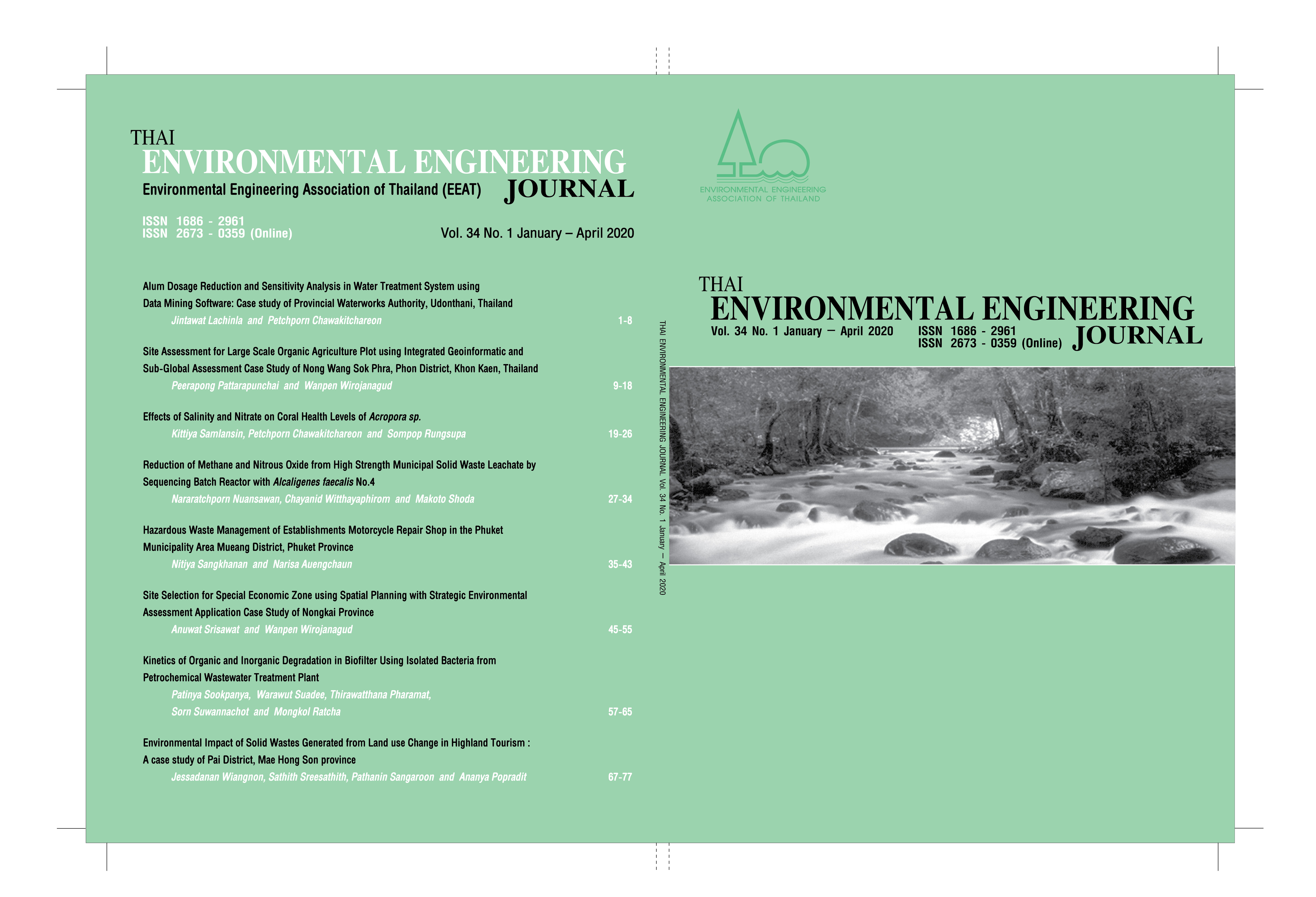Alum Dosage Reduction and Sensitivity Analysis in Water Treatment System using Data Mining Software: Case study of Provincial Waterworks Authority, Udonthani
Main Article Content
Abstract
This research applied RapidMiner V.9.2 for alum dosage reduction and sensitivity analysis in water supply system of PWA, Udonthani. The input parameters were pH and turbidity of raw water, pH and turbidity of pre-filtered water. The output parameter was alum dosage. The data were used from October, 2004 to April, 2019 that collected 5,118 records. The theory used W-LinearRegression W-MLP W-REPTree W-M5P W-M5Rules and GBT for modeling, alum dosage prediction, apply to alum dosage reduction and sensitivity analysis. From all 24 scenarios experiment, in conclusion, 10 models could be the alum dosage prediction. When applied to reduce the alum using dosage and sensitivity analysis, it was found model can the most alum reduction was model in summer by W-M5P theory and model in winter by GBT. All two models were used in Banthon WTP to reduce the alum dosage up to 21.69 percentage per year or 243,230 baht per year. The input parameters affected the most sensitive model that were pH and turbidity of raw water, pH of pre-filtered water. Therefore, this model could be applied to reduce cost of alum for PWA, Udonthani.
Article Details
References
Tanthunwet, M. 1999. Water Supply Engineering. 1000, 3. Bangkok: Chulalongkorn University.
Provincial Waterworks Authority. 2018. Guide: Process of Water Supply and Water Quality Control.
Wangpyasan, T. 2014. Water Supply Engineering. 2000, 2. Bangkok: Chulalongkorn University.
Somkraisornkij, P. 2007. Coagulation and Flocculation Process [Online]. Available from: https://www.mwa.co.th/ewt_dl_link.php?nid=441 [2019, April 28].
Crittenden, J. C., Trussell, R. R., Hand, D. W., Howe, K. J. and Tchobanoglous, G. 2012. MWH's water treatment: principles and design. 3. Canada: John Wiley & Sons, Inc., Hoboken, New Jerscy.
Provincial Waterworks Authority. 2017. Method: Jar-Test [Online]. Available from: https://www.oic.go.th/FILEWEB/CABINFOCENTER38/DRAWER032/GENERAL/DATA0000/00000054.PDF [2019, June 1].
Chawakitchareon, P., Boonnao, N., and Charutragulchai, P. 2017. Prediction of Alum Dosage in Water Supply by WEKA Data Mining Software. Information Modelling and Knowledge Bases XXVIII, 2: 83-92.
Abdullahi, M. E., Folorunsho, A. D., Agaie, B. G., and Jibril, M. 2012. Predictive Model for Lime Dosage in Water Treatment Plant. International Journal of Scientific and Research Publications (IJSRP), 2: 230-233.
Natitaweetrab, C. 2012. Weight-Based Growth Model for Nile Tilapia in Waste Water Treatment Pond without Feeding. Master's thesis. Department of Mathematics and Computer Science, Faculty of Science, Chulalongkorn University.
Auwatanamongkol, S. 2018. Data Mining. 562, 2.Bangkok: National Institute of Development Administration (NIDA).
Yimngam, A. 2019. Data Mining. [Online]. Available from: https://compcenter.bu.ac.th/
news-information/data-mining [2019, April 28]
Katanyukul, T. 2018. Basic Machine Learning. 100, 1. Khonkaen: Faculty of Engineering, Khon kaen University.
Wareeprasert, N. and Ladi, N. 2009. Artificial intelligence. 1. Bangkok : KTP Comp & Consulting.
Sinsomboonthong, S. 2018. Data Mining 1. 2000, 2. Bangkok: Chamchuri Products.
Thipnang, A. 2018. Enhancing Alum Dosage Prediction Accuracy in Coagulation Process by Data Mining Software: A Case Study of Bang khen Water Supply Plant, Bangkok, Thailand. Master's thesis. Department of Environmental and Energy Engineering for Sustainability, Faculty of Engineering, King Mongkut’s Institute of Technology Ladkrabang.
Nuengkham, C. 2019. Gradient Boosting Machine[Online]. Available from: https://medium.com/cw-quantlab/optimize-trading-system-with-gradient-boosting-machine-8db7d392f92d [2019, September 16].


